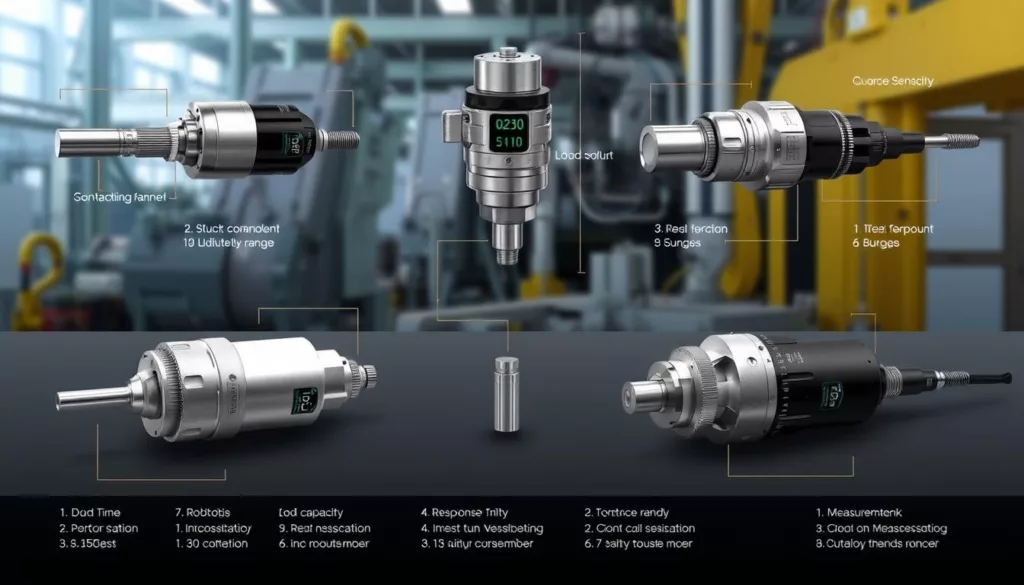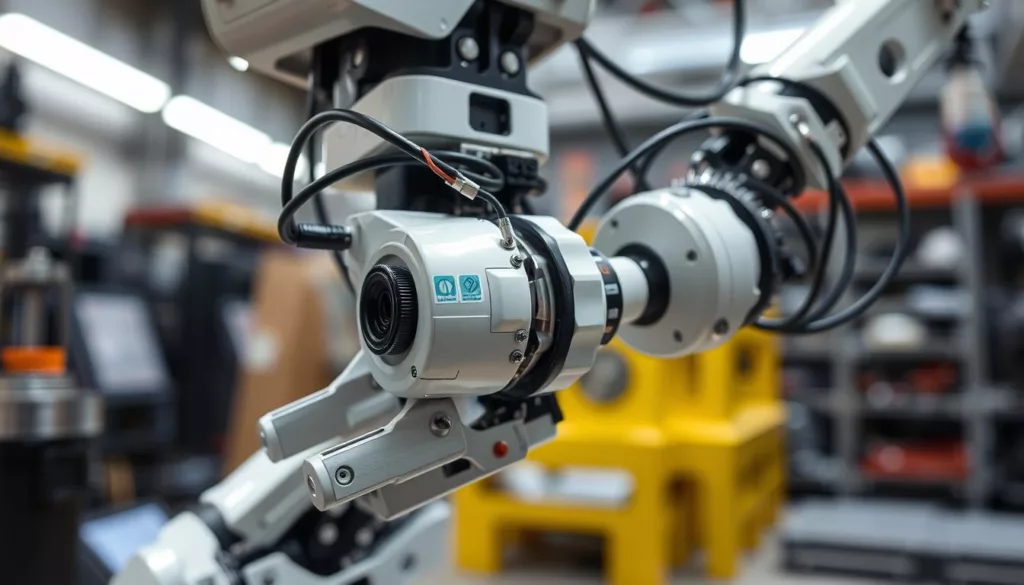In the fast-changing world of robotics, picking the right torque sensor is key. It greatly affects how well and safely robots work. This guide will cover the basics of measuring torque, the different types of sensors, and what to look for when choosing one. Knowing how torque sensing helps control robots will help you make better choices for your robotic projects.
Key Takeaways
- Torque sensors are essential for controlling, monitoring, and improving robot performance.
- It’s important to understand how torque is measured to pick the right sensor.
- Look at accuracy, resolution, range, and how well the sensor responds to changes.
- Things like temperature, humidity, and vibration can affect a sensor’s durability and reliability.
- Getting the torque sensor to work well with your robot system can be a challenge.
Understanding Torque Sensors in Robotics Applications
In robotics, torque sensors are key for precise control and top performance. They measure the rotational force, or torque, on a robot’s joints. This feedback helps the control system adjust, making the robot work better.
Basic Principles of Torque Measurement
Torque sensors use technologies like strain gauges, piezoelectric elements, or optical encoders. They turn the rotational force into an electrical signal. The robot’s control system then uses this signal to adjust its movements.
Role of Torque Sensing in Robot Control
Accurate torque sensing is vital for robot control. It lets the control system adjust the robot’s movements in real-time. This is key for delicate tasks or when robots work with humans, like in surgery or manufacturing.
Impact on Robot Performance and Safety
Torque sensors greatly improve robot performance and safety. They help control the robot’s movements, making it more accurate and efficient. They also prevent joint overload, keeping the robot and its surroundings safe.
| Torque Measurement Technology | Advantages | Disadvantages |
|---|---|---|
| Strain Gauge |
|
|
| Piezoelectric |
|
|
| Optical Encoder |
|
|
Understanding torque measurement for robots is key. It helps us see how torque sensing technologies improve control systems. This knowledge unlocks the full power of robotics, ensuring safe, efficient, and precise operation.
Types of Torque Sensors Available for Robotics
When picking the best torque sensor for robots, there are several options. Each type has its own benefits and drawbacks. It’s important to know what your robot needs to pick the right one.
Strain Gauge-Based Torque Sensors
Strain gauge sensors are a top choice for robots. They’re accurate, reliable, and affordable. These sensors measure how much a shaft bends when twisted, giving precise readings. They work well in many fields, from factories to medical robots.
Optical Torque Sensors
Optical sensors use light to detect twists. They’re very precise, respond quickly, and don’t get affected by magnetic fields. But, they cost more than other types.
Magnetoelastic Torque Sensors
Magnetoelastic sensors use magnets to measure twists. They’re tough, last long, and work well in rough places. They’re great for heavy-duty robots that face a lot of shock and vibration.
| Sensor Type | Advantages | Limitations |
|---|---|---|
| Strain Gauge-Based |
|
|
| Optical |
|
|
| Magnetoelastic |
|
|
Knowing the good and bad of each sensor helps you choose the best one for your robot. This ensures your robot works well and safely.
“Choosing the right torque sensor is key for a robot’s best performance and safety.”
Key Specifications and Performance Metrics
Choosing the right torque sensor for robots is key. You need to look at several important specs and how well they perform. Things like accuracy, resolution, operating range, and how fast the sensor responds are all vital.
Accuracy and Resolution Requirements
Accuracy is top when picking a torque sensor for robots. Robots need to measure torque precisely for the best control. Look for sensors with high accuracy, shown as a percentage of the full-scale output. Also, the sensor’s resolution is key. It shows the smallest change in torque it can detect. A higher resolution means better control and performance.
Operating Range Considerations
The operating range of a torque sensor must fit your robot’s needs. Think about the lowest and highest torque your robot will use. Choose a sensor that can handle those levels. This ensures your robot gets accurate torque feedback for better control.
Dynamic Response Characteristics
Robotics often need sensors that respond quickly. Look for sensors with a high bandwidth and fast response time. This is important for fast movements, quick force changes, or delicate tasks.
By checking these specs and performance, you can pick a torque sensor that meets your needs. It will give your robot the accurate and fast torque feedback it needs for top performance.
“Accurate and responsive torque sensing is the foundation for precise robotic control and high-performance operation.”
Choosing the Right Torque Sensor for Robotics
When picking a torque sensor for your robot, several important factors come into play. The right sensor can greatly improve your robot’s performance, safety, and how well it fits into your system. Let’s look at the key things to consider to find the best torque sensor for your needs.
Load Capacity and Sensor Size
The load capacity of the torque sensor is a major factor. You need to think about the torque your robot will handle and pick a sensor that can handle it. Also, the sensor’s size must fit in your robot’s design.
Mounting Options and Compatibility
The way you mount the torque sensor is key for a smooth fit. Look at the different mounting options like flange, shaft, or in-line. Make sure it fits securely in your robot’s structure.
Control System Integration
It’s also important that the torque sensor works well with your robot’s control system. Check if the sensor’s signals, communication, and software fit with your robot’s setup.
| Specification | Recommended Range |
|---|---|
| Torque Range | 0.1 Nm to 1000 Nm |
| Accuracy | ±0.1% to ±1% of full scale |
| Bandwidth | Up to 1 kHz |
| Mounting | Flange, shaft, or in-line options |
| Output Signal | Analog, digital, or fieldbus protocols |
By thinking about these key points, you can make sure you choose the right torque sensor for your robot. This will improve your robot’s performance, safety, and how well it works with your system.
“The right torque sensor can be the difference between a robot that operates smoothly and safely, and one that struggles with control and stability.”
Environmental Considerations and Durability Factors
When picking torque sensing technologies for robots, think about the environment and how long they last. The sensor’s performance can change a lot due to temperature, humidity, shock, and vibration. It’s key to choose a sensor that can handle these challenges well.
Temperature and Humidity Effects
Torque sensors for robots need to work well in many temperatures and humidity levels. Extreme heat, cold, or moisture can mess with their accuracy and function. Look for sensors with temperature control and sealed designs to fight off environmental effects.
Shock and Vibration Resistance
Robots work in places with lots of shock and vibration. The sensors must stay strong and accurate under these conditions. Using strong materials and special sensing elements can help a sensor handle these stresses better.
IP Ratings and Protection Standards
For torque sensors to last long in robots, check their IP rating and protection standards. Sensors with high IP ratings, like IP65 or higher, keep dust, water, and other stuff out. This is important to keep the sensor working right and avoid early failure in tough places.
By thinking about these environmental and durability needs, you can pick the best torque sensing technologies for robots. This ensures your robots work well and last a long time.
Integration Challenges and Solutions
Adding robot joint torque sensing tech to robots can be tricky. You need to think about wiring, signal processing, and how it connects to the robot’s brain. This careful planning ensures the robot gets the right feedback.
One big challenge is making sure the sensor and controller talk to each other well. Using the right cables and keeping them safe from interference is key. Also, picking the right connectors and adding strain relief helps keep the connection strong.
Getting the sensor data right is also important. Torque sensors need special tools to make their data useful for the robot. It’s all about scaling, filtering, and making the data linear for accurate readings.
- Wiring and Cabling: Optimize sensor-to-controller connections for reliable signal transmission.
- Signal Conditioning: Implement specialized amplifiers and signal processing to ensure data integrity.
- Controller Integration: Seamlessly interface the torque sensor with the robot’s control system.
By tackling these challenges, robotics experts can make robots better at controlling themselves. This leads to more precise and safer robots in many fields.
“Successful integration of torque sensors is key for better robot control, precision, and safety.”
Maximizing Sensor Integration Efficiency
To make integrating torque sensors easier, working with experts is a must. They know the best sensors, wiring, and how to put it all together. Their advice is based on what works best for your specific needs.
Cost Analysis and ROI Considerations
Choosing the right torque sensor for robots is key. It’s important to look at the cost and long-term gains. A good torque sensor might cost more upfront, but it can save you money in the long run.
Initial Investment vs. Long-term Benefits
The cost of a top-notch optimal torque sensor for robotic applications might seem high at first. But think about the benefits it brings. These sensors are accurate, reliable, and last long. They make your system work better, need less fixing, and last longer.
By picking the right torque sensing requirements in robotics, you boost your robot’s performance. You’ll save energy, work more efficiently, and keep your robots safe.
Maintenance and Calibration Costs
- High-quality torque sensors need less upkeep and calibration, saving you money over time.
- They give precise and steady readings, so you don’t have to calibrate them as often.
- They also help you plan maintenance, so you can avoid unexpected downtime.
Performance Impact on Overall System
The quality of your optimal torque sensor for robotic applications affects your robot’s performance. Good torque control means better energy use, safety, and longer component life. This makes your investment worthwhile.
“Investing in the right torque sensing solution for your robotic applications can unlock a wealth of long-term benefits, from enhanced productivity to improved safety and cost savings.”
Conclusion
Choosing the right torque sensor for robotics is key for better precision, efficiency, and safety. This guide has covered the basics of torque measurement and the different types of sensors. It helps professionals and engineers make the right choices for their robotics needs.
The right sensor makes a big difference. It helps robots work more accurately and safely. By looking at important specs, environmental factors, and cost, you can choose wisely. This ensures your robotics system works well and is safe.
XJCSENSOR leads in sensor technology, pushing the limits of precision and control in automation. Their work helps robotics experts get the most out of their systems. This leads to better productivity, safety, and sustainability in many industries.






